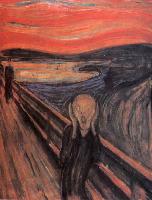TCF112/German Silent Film
From Screenpedia
Jump to navigationJump to searchGermany After World War I
- 1919: World War I ends.
- Country plunged into financial and social chaos.
German Silent Film
- Historical/Mythological Films
- Expressionist Films
- Kammerspielfilm
Historical/Mythological Films
Influenced by theatrical producer Max Reinhardt.
- Huge architectural sets.
- Careful period costuming.
- Chiaroscuro lighting.
- Large casts and movement on stage.
Expressionist Films
Expressionist paintings influence films. See examples of Expressionist art.
- Style distorted to express the artist's inner torment.
- Fascination with death, disease, illness, depression, melancholy, etc. . . .
Expressionist Cinema Characteristics
E.g., The Cabinet of Dr. Caligari, Robert Wiene, 1919.
- Subject matter/Content
- Theme
- Horror, dark fantasy, the Gothic.
- Illness, death, insanity.
- Theme
- Visual Style
- Mise-en-scene
- Set design, lighting, costume design (props), blocking (actor movement).
- Sets express inner state of characters
- Lighting stylized to express inner states
- Performance Style/Blocking--jerky gestures express inner torment
- Set design, lighting, costume design (props), blocking (actor movement).
- Cinematography
- Such as focus, framing, camera movement, film stocks
- Stationary camera
- Long shots (few close-ups)
- Minimal editing
- Such as focus, framing, camera movement, film stocks
- Mise-en-scene
Kammerspielfilm
Kammer = chamber/room Spiel = play Kammerspiel = chamberplay
Inspired by producer Max Reinhardt's work in the theater.
- Intimate stories about everyday people.
- Camera movement.
- Lack of intertitles.
